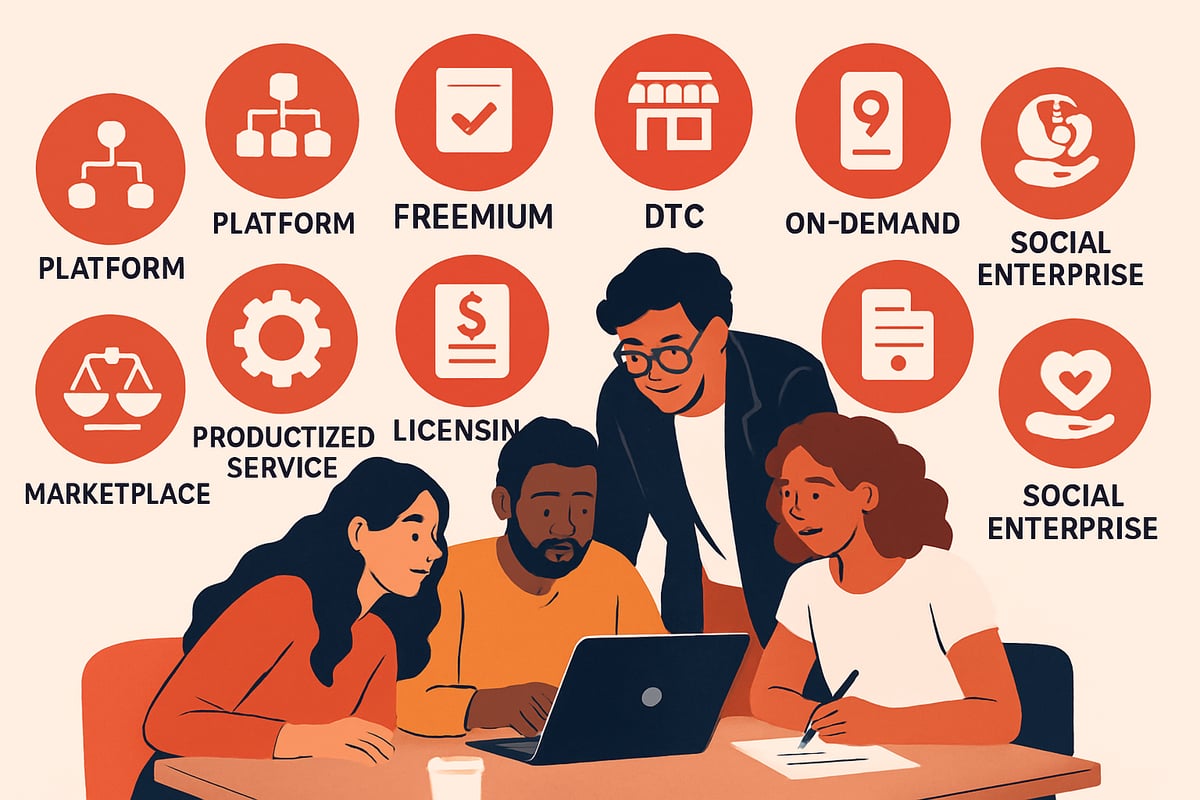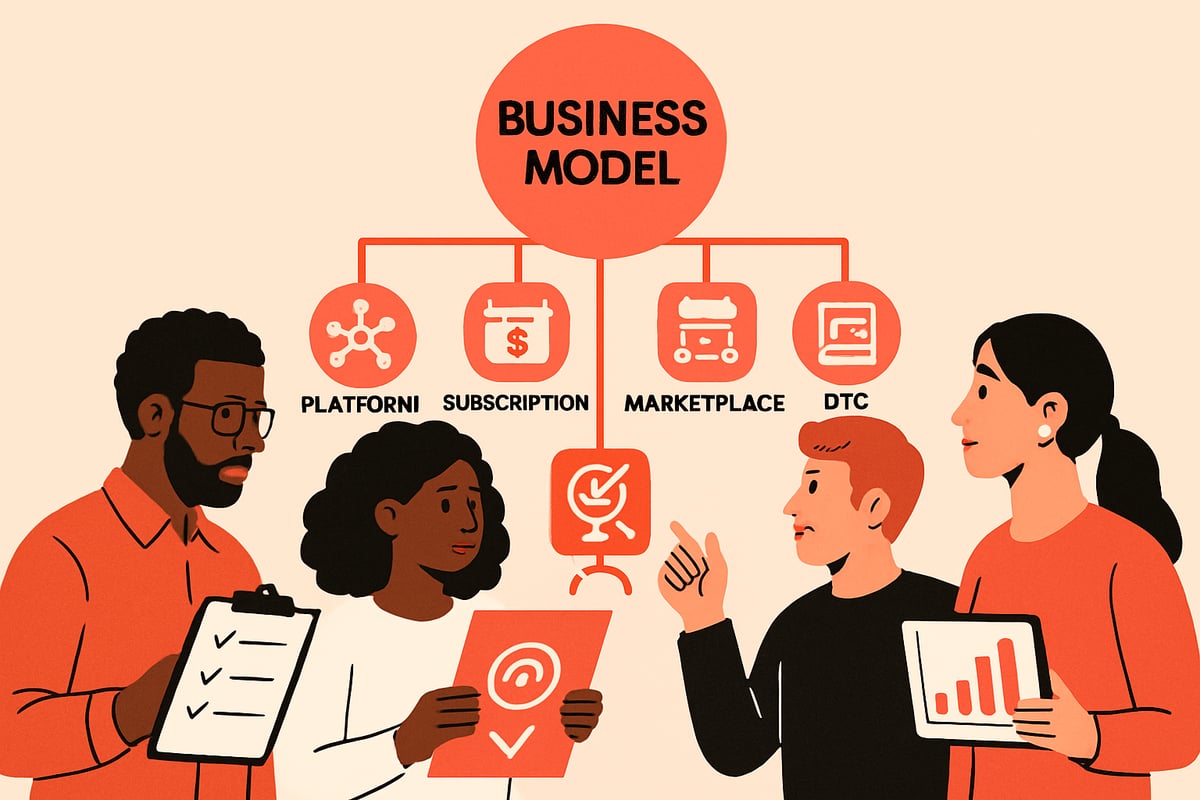9 Essential Business Models for Startups in 2025
The startup world is moving faster than ever, with new trends and technologies reshaping the way founders build companies. Success in 2025 will depend on how well you choose and adapt business models for startups to fit this dynamic environment.
This article explores nine essential business models that every startup should consider. From subscription and platform models to impact-driven approaches, these models are designed to help you navigate change and seize new opportunities.
You will discover the strengths, challenges, and best-fit scenarios for each model, backed by real-world examples and actionable advice. Ready to future-proof your venture? Let's dive in and find the right fit for your vision.
The Evolving Startup Landscape in 2025
The startup world is evolving at breakneck speed. Founders must stay ahead by understanding how business models for startups are shifting in 2025. From tech breakthroughs to the growing focus on sustainability, the landscape is full of opportunity and challenge.

Key Trends Shaping Startup Business Models
Several trends are reshaping business models for startups. Digital transformation and AI are now at the heart of nearly every sector. Sustainability is a core value, not just a buzzword. Remote work is expanding global talent pools, while consumers want subscription and on-demand services more than ever. Platform-based and ecosystem-driven approaches are also gaining ground. For a deeper dive into these startup industry trends for 2025, check out this resource.
The Impact of Technology and Innovation
Technology is unlocking new possibilities for business models for startups. AI, blockchain, and automation are powering fresh ideas and smarter operations. Startups using these tools can offer better personalization and efficiency. For example, AI-driven platforms help founders make data-driven choices, giving them a competitive edge. Case studies show that those who embrace innovation often outpace traditional competitors, especially when they let data guide their business model selection.
Investor Expectations and Market Validation
Investors in 2025 are laser-focused on scalable business models for startups. They want to see recurring revenue, strong margins, and models with built-in defensibility. Scalability is key, as is the ability to prove real market demand. Startups that can showcase a robust business model often secure funding faster. Recent success stories highlight that a clear path to recurring income and evidence of market validation are magnets for investor interest.
Challenges and Opportunities for New Ventures
Choosing the right business models for startups is not without challenges. Many founders struggle with regulatory rules, especially when entering new markets. Common pitfalls include failing to differentiate or pivot in time. Yet, these challenges present opportunities. Startups that focus on unique value, compliance, and customer-centric solutions often stand out. Navigating these waters requires awareness, agility, and a willingness to learn from both failures and successes.
The Importance of Flexibility and Adaptability
In 2025, flexibility is crucial for business models for startups. The best founders are always ready to adapt, iterate, or pivot based on market feedback. Real-world examples show that companies willing to change course often survive disruptions and even thrive. Being open to evolution helps startups stay relevant, resilient, and positioned for long-term success.
9 Essential Business Models for Startups in 2025
The landscape of business models for startups is more diverse than ever in 2025. With technology, consumer behavior, and competition evolving at breakneck speed, selecting the right approach can be the difference between scaling quickly or stalling out. Below, we break down the nine most impactful business models for startups this year, helping founders navigate their options with clarity and confidence.

1. Platform Model
The platform model connects two or more user groups, such as buyers and sellers, through a digital space. This business model for startups thrives on network effects, where the value increases as more users join. Platforms leverage data-driven personalization and often use advanced algorithms to match users efficiently.
Key features include scalability, the ability to adapt quickly, and diverse revenue streams. The platform model is ideal for startups aiming to build marketplaces or facilitate third-party interactions. Examples include Airbnb, Upwork, and Shopify, each demonstrating rapid growth and high profit margins.
Pros:
- Scalable and asset-light
- High user engagement
- Multiple revenue streams
Cons:
- Significant upfront investment
- Solving the chicken and egg problem (attracting both sides)
- Navigating regulatory complexities
If you want to dive deeper into how to build a robust platform or any other business models for startups, check out How to Create a Business Model.
2. Subscription Model
The subscription model is all about recurring revenue. Customers pay a regular fee for ongoing access to products or services, making this one of the most popular business models for startups in SaaS, media, and even consumer goods. Predictable income and customer retention are the main attractions here.
Startups using this model can easily forecast revenue and plan for growth. Tiered pricing and ongoing value delivery encourage customer loyalty. Netflix, Adobe Creative Cloud, and HelloFresh are leading examples, showing how diverse industries can leverage subscriptions.
Pros:
- Stable, predictable revenue
- Higher customer lifetime value
- Easier revenue forecasting
Cons:
- Managing churn rates
- Constant need to deliver value
This business model for startups works best when you can consistently meet or exceed customer expectations, making retention a key focus area.
3. Freemium Model
The freemium model offers basic services for free while charging for premium features or enhancements. For many digital products, this is a proven business model for startups seeking rapid user acquisition and organic growth.
Large user bases drive network effects, and data collected from free users can inform upselling strategies. Spotify, Dropbox, and Slack are well-known for successfully converting free users into paying customers.
Pros:
- Fast user growth
- Built-in virality and word-of-mouth marketing
- Easy entry for new users
Cons:
- Conversion to paid can be challenging
- Support costs for free users
Startups choosing this business model for startups must balance the value of free offerings with compelling paid features to drive revenue.
4. Direct-to-Consumer (DTC) Model
The DTC business model for startups allows brands to sell directly to customers, bypassing traditional retailers and middlemen. This gives startups complete control over their brand, customer experience, and data.
With DTC, startups like Warby Parker, Glossier, and Casper have built strong brand loyalty and agile marketing strategies. The ability to personalize offers and respond quickly to feedback is a significant advantage.
Pros:
- Full control over branding and messaging
- Direct access to customer insights
- Higher profit margins
Cons:
- Complex logistics and fulfillment
- High customer acquisition costs
This business model for startups suits those ready to handle end-to-end operations and willing to invest in building a loyal customer base.
5. On-Demand Model
The on-demand model delivers goods or services instantly, often through mobile apps. For startups, this business model for startups is all about convenience, real-time delivery, and leveraging flexible workforces.
Uber, DoorDash, and TaskRabbit are prime examples, thriving by matching demand with supply efficiently. Startups in transportation, food delivery, and home services can scale quickly using this model.
Pros:
- High user engagement and satisfaction
- Rapid scalability in local markets
- Valuable data collection on user behavior
Cons:
- Operational complexity and logistics
- Navigating regulations and labor laws
Startups adopting this business model for startups must excel in technology and operations to stand out in competitive markets.
6. Marketplace Model
A marketplace model facilitates transactions between buyers and sellers, earning commissions or fees. This business model for startups is asset-light and highly scalable, making it attractive for those wanting to build a community-driven platform.
Trust mechanisms, payment facilitation, and user reviews are core features. Successful examples like Etsy, Fiverr, and StockX show how marketplaces can thrive in niche verticals or peer-to-peer services.
Pros:
- Low inventory risk
- Diverse product or service offerings
- Community-driven growth
Cons:
- Quality control challenges
- Need to acquire both buyers and sellers
For startups, this business model for startups works best when you can build trust and maintain quality on both sides of the transaction.
7. Productized Service Model
The productized service model packages services into standardized, repeatable offerings. This business model for startups is popular among agencies and consultancies seeking predictable delivery and streamlined operations.
Startups like Design Pickle, Bench, and WP Buffs have scaled by automating processes and offering fixed pricing and clear deliverables. This approach simplifies sales and increases margins.
Pros:
- Streamlined, efficient operations
- Easier sales process
- Higher profit margins
Cons:
- Less room for customization
- Risk of commoditization
Startups using this business model for startups must focus on clear value propositions and process automation for success.
8. Licensing & White Label Model
Licensing and white label models allow startups to monetize intellectual property by letting other businesses use or resell their products. This business model for startups is ideal for technology, software, and manufacturing, where IP protection and recurring royalties are key.
Dolby, ARM Holdings, and white-label fintech platforms are excellent examples. Startups benefit from low operational overhead and the ability to scale rapidly through partners.
Pros:
- Scalable and low risk
- Passive income through royalties
- Leverages existing assets
Cons:
- Limited control over end-user experience
- Dependency on partner performance
This business model for startups suits those with valuable IP and a strategy for managing external relationships.
9. Impact/Social Enterprise Model
The impact or social enterprise model puts social or environmental goals at the heart of the business. This business model for startups combines profit with purpose, attracting both impact investors and loyal customers.
Startups like TOMS, Too Good To Go, and Ecosia are leading the way, focusing on transparent impact metrics and community engagement. Access to regulatory incentives and positive PR are additional benefits.
Pros:
- Strong differentiation and brand loyalty
- Purpose-driven culture attracts talent
- Access to unique funding sources
Cons:
- Balancing profit and purpose can be tough
- Measuring and reporting impact is complex
For startups passionate about change, this business model for startups offers a compelling path to make a difference while building a sustainable business.
Choosing the Right Business Model for Your Startup
Selecting the right business models for startups can make the difference between scaling up and struggling to survive. With so many options available, founders must evaluate each model carefully to align with their unique goals, resources, and market realities. Let’s break down the essential steps to guide your choice.

Assessing Market Fit and Customer Needs
Understanding your target audience is the foundation of all successful business models for startups. Start by identifying your ideal customer profile and mapping out their pain points. Use tools like customer interviews, surveys, and MVP launches to validate your assumptions.
Consider how similar startups have pivoted after learning from early user feedback. For more in-depth perspectives, you can explore Entrepreneurial Models Explained to see how various business models for startups have evolved based on market needs.
List of validation tools:
- Online surveys (Google Forms, Typeform)
- MVPs and prototypes
- One-on-one interviews
- A/B testing
When you listen and adapt to your market, you increase the odds of building a model that resonates with real-world demand.
Evaluating Revenue Potential and Scalability
Next, analyze the earning potential and scalability of your chosen business models for startups. It’s crucial to understand key metrics such as:
| Metric | What It Measures |
|---|---|
| ARPU | Average revenue per user |
| CAC | Customer acquisition cost |
| CLTV | Customer lifetime value |
| Gross Margin | Profitability of your offering |
Forecasting revenue streams helps you plan for growth and attract investors. Look for models that offer recurring income, such as subscriptions or marketplaces. Case studies show that scalable business models for startups often outperform those with limited growth capacity.
When you prioritize models with strong financial fundamentals, you lay the groundwork for sustainable expansion.
Considering Operational Complexity and Resources
Not all business models for startups require the same resources. Assess your team’s strengths, available capital, and operational bandwidth. Some models, like productized services or DTC, may demand robust logistics and customer support.
Ask yourself:
- Can you outsource key functions, or must they stay in-house?
- Do you have the technology or manpower to deliver at scale?
- What are the upfront costs versus long-term gains?
For service-focused founders, Service Startup Business Models offers insights into resource-light models that might suit your team. Balancing ambition with operational reality helps you avoid overextending and ensures steady growth.
Legal, Regulatory, and Ethical Considerations
Every business model comes with its own set of compliance requirements. Stay informed about local and international regulations that apply to your industry. Transparency and ethical business practices are more important than ever for startups aiming to build trust.
Before launching, review contracts, data privacy policies, and any necessary licenses. Keeping your business models for startups above board protects your reputation and helps you avoid costly setbacks.
Future-Proofing Your Startup’s Business Model
Adapting to change is essential for startups that want to remain competitive in 2025. With technology and market trends evolving faster than ever, future-proofing your business models for startups is not just smart, it is necessary for survival. Let’s break down how founders can build resilience, stay innovative, and keep pace with the shifting landscape.

Embracing Innovation and Continuous Improvement
Startups must foster a culture where experimentation and rapid iteration are the norm. Encourage your team to test new ideas, learn from failures, and celebrate small wins. Leveraging the latest technology can unlock new opportunities for optimizing operations and scaling efficiently.
For example, many modern business models for startups rely on AI-driven analytics to personalize user experiences or automate workflows. Companies like Adobe and Slack have evolved their models, integrating continuous feedback loops and technology upgrades to stay ahead. The key is to remain proactive, always seeking ways to refine and enhance your offering.
Monitoring Trends and Adapting to Change
Staying informed about market shifts is crucial. Regularly analyze industry data and competitor moves to spot emerging opportunities or threats. Tools like Google Trends, competitor monitoring platforms, and industry reports can help you anticipate changes before they disrupt your business.
For the latest insights, review Global startup industry statistics 2025 to understand how business models for startups are evolving worldwide. Use this information to adjust your strategy, whether that means pivoting your product, exploring new revenue streams, or entering untapped markets.
Building Resilience Against Disruption
Diversifying revenue streams and customer segments can help shield your startup from sudden shocks. Consider creating a table to assess your current risk exposure:
| Risk Factor | Current Impact | Mitigation Plan |
|---|---|---|
| Regulatory Change | Medium | Monitor policy, adapt |
| Market Competition | High | Differentiate offer |
| Tech Disruption | Low | Invest in R&D |
Business models for startups that survived major disruptions often had multiple income sources or could quickly shift focus. Prepare contingency plans for regulatory shifts, supply chain interruptions, or changes in consumer demand. The startups that thrive are those that stay nimble and ready for anything.
Now that you’ve explored the nine essential business models shaping startups in 2025, it’s the perfect time to connect with other Swiss founders navigating similar challenges and opportunities. Being part of a supportive network can make all the difference when you’re refining your model, seeking feedback, or looking for inspiration. If you’re ready to learn from real experiences, share your own journey, and get plugged into Switzerland’s thriving entrepreneurial ecosystem, I encourage you to apply to our swiss founders community. Let’s grow and innovate together!

